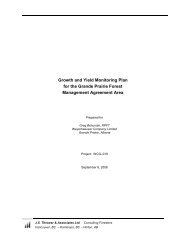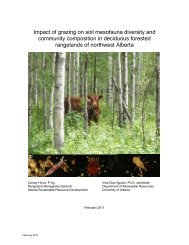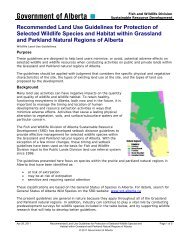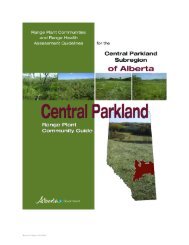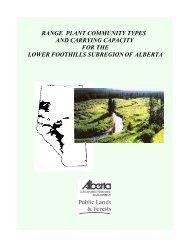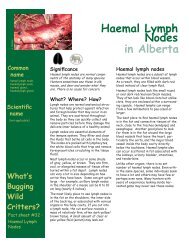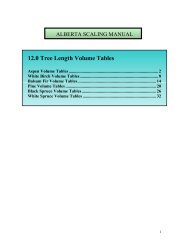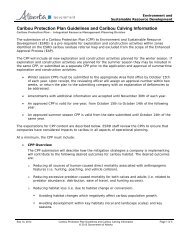Foothills Fescue Range Plant Community Guide - Sustainable ...
Foothills Fescue Range Plant Community Guide - Sustainable ...
Foothills Fescue Range Plant Community Guide - Sustainable ...
Create successful ePaper yourself
Turn your PDF publications into a flip-book with our unique Google optimized e-Paper software.
<strong>Foothills</strong> Rough <strong>Fescue</strong> - Idaho <strong>Fescue</strong> - Sedge - FFA2<br />
(Festuca campestris - Festuca idahoensis - Carex spp.) Herbaceous<br />
n=28 This is the reference plant community for black loamy sites in the <strong>Foothills</strong> <strong>Fescue</strong> grassland.<br />
Soils are medium textured, well drained Orthic Black Chernozems and surface Ah horizons of 10 - 15 cm<br />
in thickness (normally 10 - 15 cm). This community type occurs on very similar soils to FFA5, but is more<br />
common in the southern portion of the subregion, on black soils adjoining the Mixedgrass prairie and areas<br />
of higher summer temperature extremes like the Oldman River valley. With heavy grazing pressure, rough<br />
fescue is replaced by Idaho fescue and numerous forb species. This plant community normally has close<br />
to complete ground cover with little exposed soil. Winter Chinook winds expose this grassland type and<br />
it is commonly used for winter grazing which serves to maintain a high abundance of rough fescue. Forage<br />
production data presented here is from the Waldron Ranch rangeland reference area.<br />
Soil Exposure: 9 % (1-28)Moss/Lichen Cover: 7 % (1 - 35) Total Vegetation: 77% (45 - 96%)<br />
PLANT COMPOSITION CANOPY COVER(%)<br />
MEAN RANGE CONST<br />
SHRUBS<br />
CREEPING JUNIPER<br />
(Juniperus horizontalis) T 0-7 8<br />
FORBS<br />
THREE-FLOWERED AVENS<br />
(Geum triflorum) 2 0-15 39<br />
GRASSES<br />
FOOTHILLS ROUGH FESCUE<br />
(Festuca campestris) 36 13-59 100<br />
IDAHO FESCUE<br />
(Festuca idahoensis) 12 2-35 100<br />
UNDIFFERENTIATED SEDGE<br />
(Carex) 9 0-16 93<br />
NORTHERN WHEAT GRASS<br />
(Agropyron dasystachyum)5 0-14 96<br />
WESTERN PORCUPINE GRASS<br />
(Stipa curtiseta) 6 0-25 75<br />
CALIFORNIA OAT GRASS<br />
(Danthonia californica) 3 0-19 46<br />
PARRY OAT GRASS<br />
(Danthonia parryi) 4 0-16 43<br />
JUNE GRASS<br />
(Koeleria macrantha) 3 0-9 93<br />
RICHARDSTON NEEDLE GRASS<br />
(Stipa richardsonii) 1 0-22 14<br />
ENVIRONMENTAL VARIABLES<br />
RANGE SITE<br />
LOAMY 2<br />
SOILS<br />
ORTHIC BLACK (BEAZER, DEL BONITA,<br />
BULLHORN AND STANDOFF)<br />
ELEVATION (M):<br />
M<br />
SOIL DRAINAGE:<br />
WELL DRAINED<br />
SLOPE :<br />
MODERATE, STRONG,<br />
VERY STRONG, GENTLE<br />
ASPECT:<br />
VARIABLE<br />
FORAGE PRODUCTION (LB/AC)<br />
GRASS 1340 (351 - 1909)<br />
FORB 221 (106 - 362)<br />
SHRUB NOT AVAILABLE<br />
LITTER 1126 (721 - 1982)<br />
TOTAL 1561 (713 - 2015)<br />
Ecologically <strong>Sustainable</strong> Stocking Rate<br />
0.55 Aum/ac<br />
33



